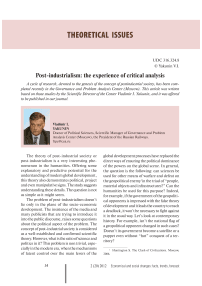Post-industrialism: the experience of critical analysis
Автор: Yakunin Vladimir Ivanovich
Журнал: Economic and Social Changes: Facts, Trends, Forecast @volnc-esc-en
Рубрика: Theoretical issues
Статья в выпуске: 2 (20) т.5, 2012 года.
Бесплатный доступ
A cycle of research, devoted to the genesis of the concept of postindustrial society, has been completed recently in the Governance and Problem Analysis Center (Moscow). This article was written based on those studies by the Scientific Director of the Center Vladimir I. Yakunin, and it was offered to be published in our journal.
Короткий адрес: https://sciup.org/147223336
IDR: 147223336 | УДК: 316.324.8
Текст научной статьи Post-industrialism: the experience of critical analysis
The theory of post-industrial society or post-industrialism is a very interesting phenomenon in the humanities. Offering some explanatory and predictive potential for the understanding of modern global development, this theory also demonstrates political, project and even manipulative signs. The study suggests understanding these details. The question is not as simple as it might seem.
The problem of post-industrialism doesn’t lie only in the plane of the socio-economic development. The insistence of the media and many publicists that are trying to introduce it into the public discourse, raises some questions about the political aspect of the problem. The concept of post-industrial society is considered as a well-established and confirmed scientific theory. However, what is the ratio of science and politics in it? This problem is non trivial, especially in the modern era, when the mechanisms of latent control over the main levers of the global development processes have replaced the direct ways of ensuring the political dominance of the powers on the global scene. In general, the question is the following: can sciences be used for other means of warfare and defeat on the geopolitical enemy1in the triad of “people, material objects and infrastructures?” Can the humanities be used for this purpose? Indeed, for example, if the government of the geopolitical opponents is impressed with the false theory of development and it leads the country to reach a deadlock, it won’t be necessary to fight against it in the usual way. Let’s look at contemporary history. For example, isn’t the national flag of a geopolitical opponent changed in such cases? Doesn’t its government become a satellite or a puppet even without “hot” conquest of a territory?
The answer is obvious. All these facts take place actually in the modern world. Do they apply to the methods and warfare between the states? It’s absolutely so. We can only have two questions.
-
1. What is a name of this type of modern weapons and what are the methods of their application, i.e. what are the types of hostilities and modern wars?
-
2. What kinds of sciences are used to develop this type of weapons and the methods of their application?
This weapon is called “informational”. Nowadays, the tools of the social sciences, which are being used as scientific rather than as a basic frame of demagoguery, is the most powerful lever of the influence on the sociopolitical processes across the globe. Were there defensive “information weapons” in Russia? Does our country use them nowadays? It’s obviously, that we seriously underestimate the problems of information security2.
The concept of post-industrialism, which has all outward signs of an artificial theoretical model used to achieve the special political goals, is studied in this context in the paper. That is why the verification of the theory of post-industrial society is a vital necessity today, not only from scientific feasibility point of view, but also from the standpoint of national security in Russia. What is real – the truth or falsity of the theory of post-industrial society? Are there any delusions or intentions under the practical guidance of this theory, if it is unreliable and destructive?
The matter of the research objectives consists of these questions. The working hypothesis is the following. Some countries reallocate their national production potentials in the world bringing out some of them in other states and, at the same time, keeping extremely profitable and ecological branches to themselves.
Thus, the world transformation of global domination and the formation of neo-colo-nialism’s fundamentals are hidden with the help of informational techniques. The essence of the research approach, implemented within the framework of this study, consists in the analysis of the theory of post-industrial society founded by D. Bell and its closest modifications that focus on the stage-branch (sectoral) approach as the characteristics for the development of society and the determinants of further changes. Sectoral production patterns (with a view to define the role of the tertiary sector of services) and sectoral occupational patterns (with a view to increase the share of employment in the service sector) are the field of analysis here as the most typical signs of the transition to a new society (fig. 1) .
Particular attention should be paid here to the verification of the theory’s fundamental thesis on the historical periodization of social production technological type (fig. 2) .
First of all, the thesis about the universality of this stage approach and the criteria for the classification of modern countries and regions with a view to its development should be verified. The main objectives of the study are the following:
-
– analysis of the theory of post-industrial society, its forming preconditions and history, the main trends and schools;
– study of the dynamics in sectoral production structure and employment in different countries, reconsideration of statistical data structure;
– the analysis based on statistical data of spatial and temporal dynamics of different types of social structures;
– opening manipulative and ideological components of the category of post-industrial society and its use as a cover for modern neocolonialism;
– assessment of the prospects for socioeconomic development of Russia in the context of the theory of post-industrial society.
Figure 1.The field of analysis of the stage-sectoral approach to the transformation of social systems
Field of analysis :
Post-industrialism

Sectoral production pattern
Sectoral occupational pattern
Figure 2. The historical periodization of technological production types in the theory of post-industrial society


It seems that we have achieved the conclusive results that confirmed the previous hypothesis in solving the problems of the study.
The theory of post-industrial society has been variously estimated for more than 50 years of its existence, ranging from such enthusiastic assessments as “the only theory of the XX century that has been confirmed in full” in the real history to such assessments as “anti-Marxism” and “ordinary bourgeois propaganda”. In fact, the theory of post-industrialism has gone beyond a purely scientific concept and has transformed into the most sophisticated ideology. And just ideological characteristics determine the basic properties of the discussions on the idea of post-industrial society among scientists and experts. There are the main controversial points noted by critics below that are the core of the expert discussion on the scientific nature of post-industrial society. At the same time, it is important to focus on those aspects that provide the “vitality” and widespread occurrence of post-industrialism ideology.
The followers of the post-industrialism theory haven’t defined clearly the notion of post-industrial society until now. Ambiguous statement of the concept of post-industrial society was typical even for the theory’s founder D. Bell. So, V.L. Inozemtsev points out in his article devoted to Daniel Bell that the uniqueness of the postindustrial society concept is precisely that “it provides a researcher with a general tool of social search and doesn’t determine the rigid framework that could be found in other sociological doctrines”3. It should be noted that it is unclear what kind of approach combines with the scientific content, which requires the clearness and maximum definiteness of the basic concepts of the study.
A serious problem for the followers of postindustrialism is the fact that many conclusions and forecasts of the post-industrial theory, made by them over a half of century, haven’t been confirmed in practice. Surprisingly, the latter fact doesn’t force the followers of this theory to doubt or reconsider the basic principles of post-industrialism. Instead of this, there are a lot of attempts to prove its worth and the apologetics of the theory of post-industrial society in scientific literature. This can be explained within the framework of a certain non-scientific determinacy of this development.
It should be recognized that some conclusions, which are made by the researchers of post-industrialism, are not really based on the analysis of actual data but on the applying results of the methods that are not scientific enough in terms of modern sociology. For example, in the absence of “reliable sociometric data”, the conclusions are grounded by personal impressions of life in America and Europe, of communication with foreign colleagues, as well as by “the comprehension of publications that throw light indirectly upon the differences, which we are interested in”4.
The followers of post-industrial society are reproached with the non-holistic ideas of society as often as with fuzzy concept of postindustrialism. The notorious prefix “post”, which implies a rejection of industrialism, doesn’t define “a new state of civilization” in terms of its positive attributes. In order to avoid a sense trap, the apologists of post-industrialism have invented the concepts of “information society” (F. Machlup and T. Umesao), techne-tronic society (Z. Brzezinski) and “knowledge society”5. However, these theories suffer from the same defect because they focus on the phenomena that don’t define the society as a social integration.
Technological determinism has obtained a strongly negative assessment today as a belief that technology plays a fundamental role in the evolution of society; according to critics, it lies in the core of the concept of post-industrial society. It’s reasonable that the opponents of post-industrialism concept criticize it for the refusal to consider the social sphere, as well as motives, objectives and social, economic and humanitarian results of used technologies.
Finally, post-industrialism critics insist not only on the fact that, despite the emergence of new products and changes in many means of production (the introduction of automatics, microelectronics, synthetic and composite materials, etc.), there are no any fundamental changes in society6. They also point out the geographic location of many post-industrial processes; there is no denying this.
Summing up the interim analysis results of the discussion on the theory of postindustrial society, it should be noted that the position of apologists is not very stable. The followers of post-industrial society haven’t disproved any moot point of their opponents.
The phenomenon of service requires the special understanding in the analysis of postindustrial society. Post-industrialism associates the prospects for the forth coming world order with its development. It is the service that is getting the main stage-replacing role in the adoption of a sectoral model of a post-industrial society.
However, this case is not so simple. The fuzzy definitions are the first things that attract attention. There is no generally accepted definition of service until now. There is no such definition not only in Russia, but also in Western science. The benchmark of post-industrial development is service, but nobody knows what it is. Its genesis is traditionally explained by the development process of labour division in the formation of new professional niche of activity. However, a more detailed historical analysis allows us to see a significant share of persons who are professionally related to service activities already in the traditional societies.
The concept of stageness in the case of service as a component of post-industrialism doesn’t look like the convincing truth. Service was historically formed together with the oldest forms of manufacturing, but it didn’t follow them stage by stage. So-called “service revolution”, which many followers of postindustrialism write about, has been reduced, in fact, to the swell of a certain service sectors over the past 40 years in some developed Western countries. Thus, it shows a clear geographical “registration” (see fig. 3 ).
There is an active growth of industrial potential in the former Third World countries that is simultaneous with the deindustrialization of the West. The current wage level of Asian and Latin American workers makes it more profitable to place industrial production in Asia or Latin America than in North America or Europe. In this case the costs are much lower at the expense of saved wages. There is a bonus in the fact that the environment load is taken out to other continents. The logic of profit maximization makes the European and American business to outsource their production to other regions of the world, therefore by this increases the industrial strength of the largest non-Western centers of power. The China’s share of industry in GDP has already surpassed the U.S. (fig. 4) .
The western industrial workers, released from the sphere of commodity production, are retrained into the workers of nonproduction sectors. Thus, the rapid development of service infrastructure in the West is a direct consequence of its deindustrialization.
The concept of post-industrialism is often used, at least in Russian public discourse, as a theoretical basis for the justification of the global trends7.
However, the analysis of long statistical arrays of the global development on the indicators of the employment structure and the structure of GDP allows us to state that there are no declared trends of the global postindustrial development in real life. Moreover, according to the structural growth dynamics in the rapidly developing countries such as China, India and Brazil, the humanity has entered the phase of neo-industrialization in the XXI century.
There is a clear trend to outsource the main industrial centers to Asia and Latin America. The current economic break down of the West seems to be especially obvious against the background of the Asian economy (fig. 5) 8.
The sustainable growth of the employment share in the industrial sector was fixed in the XX century in the non-West geographical areas (fig. 6) .
Figure 3. GDP of the leading countries by the branches of production in 2005 (according to the data of the Institute of World Economy and International Relations of RAS)
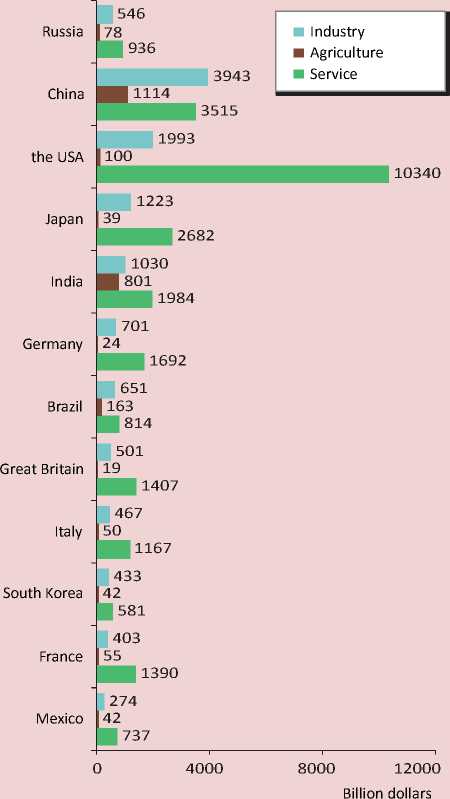
We can see the same pattern across the globe. The share of industry in the global gross domestic product has been steadily increasing since the beginning of the twentieth century except for a period of Great Depression. Nowadays, these figures are raising even faster (fig. 7) .
Thus, contrary to the forecasts of postindustrialists, today the world is entering not a post-industrial period but a neo-industrial phase of development.
The same pattern is observed in the agricultural sector. The figures, that proved the declining share of employment in agriculture, were produced repeatedly. However, these figures are ambiguous. The conclusion that there is a trend to cut back the share of agrarian production has come from the rigid differentiation of three economic sectors, which can be found practically nowhere in real life.
The modern manufacturing process has a multistep technological structure. Today there
Figure 4. The comparison of the U.S. and China’s GDP by the branches of production, billion dollars (2005) (according to the data of the Institute of World Economy and International Relations of RAS)
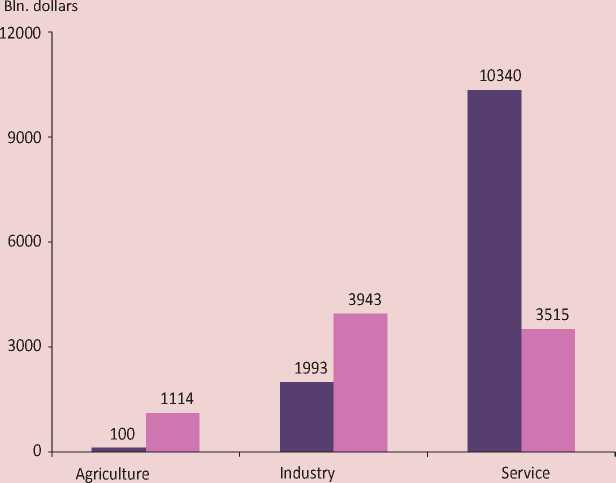
■ USA ■ China
Figure 5. The share of the Western and Asian worlds in the total amount of global production (according to the data of the Institute of World Economy and International Relations of RAS)
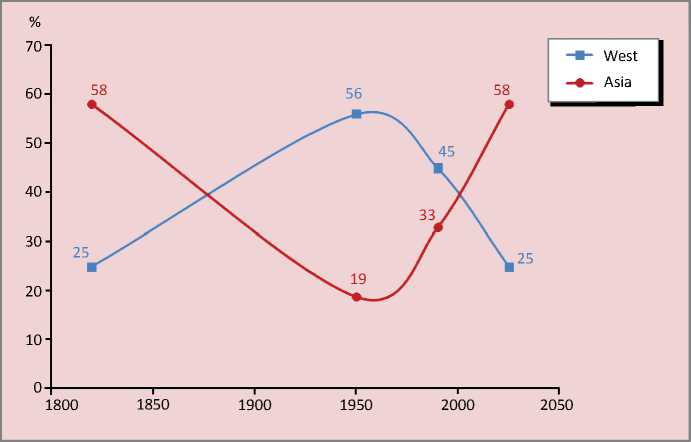
Figure 6. Industrial employment (in non-Western countries) (according to the data of the Institute of World Economy and International Relations of RAS)
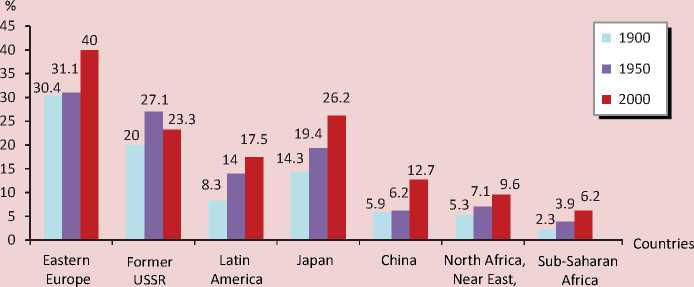
Middle East
Figure 7. The dynamics of the sectoral structure of global employment (according to the data of the Institute of World Economy and International Relations of RAS)
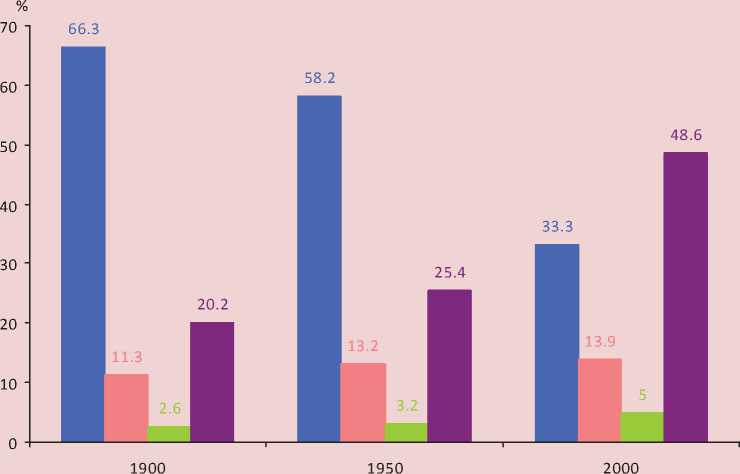
■ Agriculture ■ Industry ■ Construction ■ Service
are not so many peasants who work on the land. However, the agrarian sector is associated with a wide range of related branches. Which economic sector do they relate to, if agricultural production is a final target guide in this case? As a rule, related branches are included by modern statistics in industry or service. But is this differentiation correct?
The rapid industrial development has led the way for agriculture (fig. 8) . Technical equipment of Asian and Latin American rural areas has influenced positively over peasant labour productivity in the appropriate regions. The former periphery of the Third World is attacking the West, not only adapting the industrial technologies, but developing agriculture as a
Figure 8. The share of some non-Western countries in the global agricultural production (according to the data of the Institute of World Economy and International Relations of RAS)
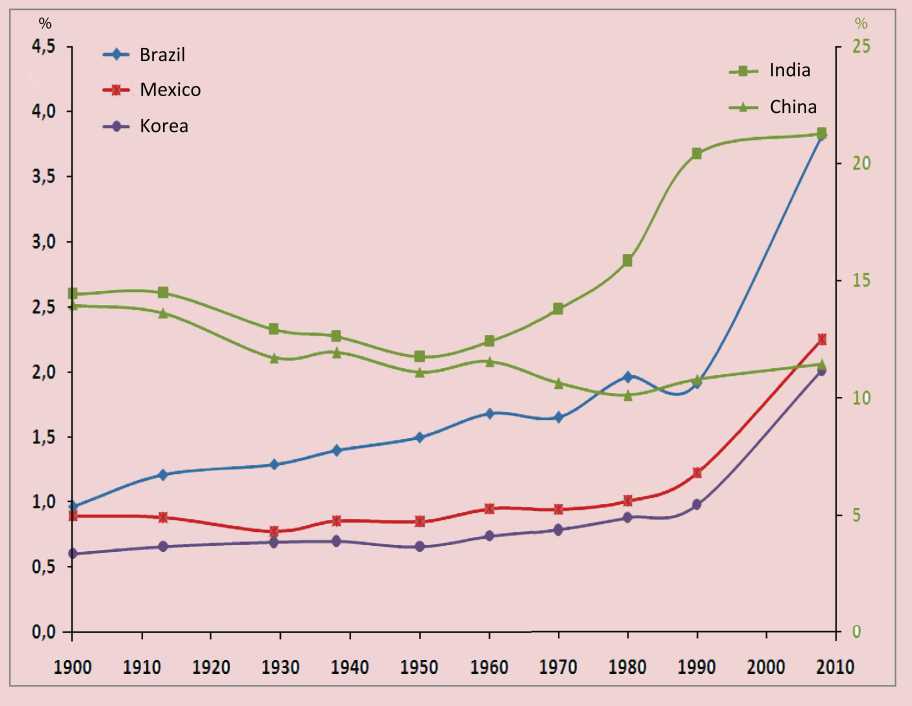
The development of agrarian sector includes not only its technical re-equipment, but also land development. This indicator is being increased in the world (fig. 10) .
It has been turned out that the basic thesis of the concept of post-industrial society on a cut back of commodity production sectors is not confirmed by its statistical verification either in time or in the geographical spaces. It is a matter of incorrect handling of actual data in the case of the industrial production and the substitution of absolute growth indicators for relative values in the agrarian production. A new geo-economic model of the global labour division, which reproduces the system of global domination in the form of the modern neo-colonialism, is issued as a trend of postindustrialism.
Thus, the wide-spread theory of postindustrialism, which aspires to have a place in world science, doesn’t stand the logical and phenomenological verification. The concept of post-industrialism goes beyond the actual scientific theory. It contains a system of ideological investments used intensively in political practice both within the Western society and in the program of globalization. The Western system acting as a global core is positioned as a service center of the world. In practice the modern scheme of servicing in the financial sense is the same scheme, which was used by parent states to extract benefits from their colonies by force. Today, geopolitical “coordinates” are linked in it to a specific structure of the sectoral division of labor (fig. 11) .
Figure 9. The leading countries in the global agricultural production (according to the data of the Institute of World Economy and International Relations of RAS)
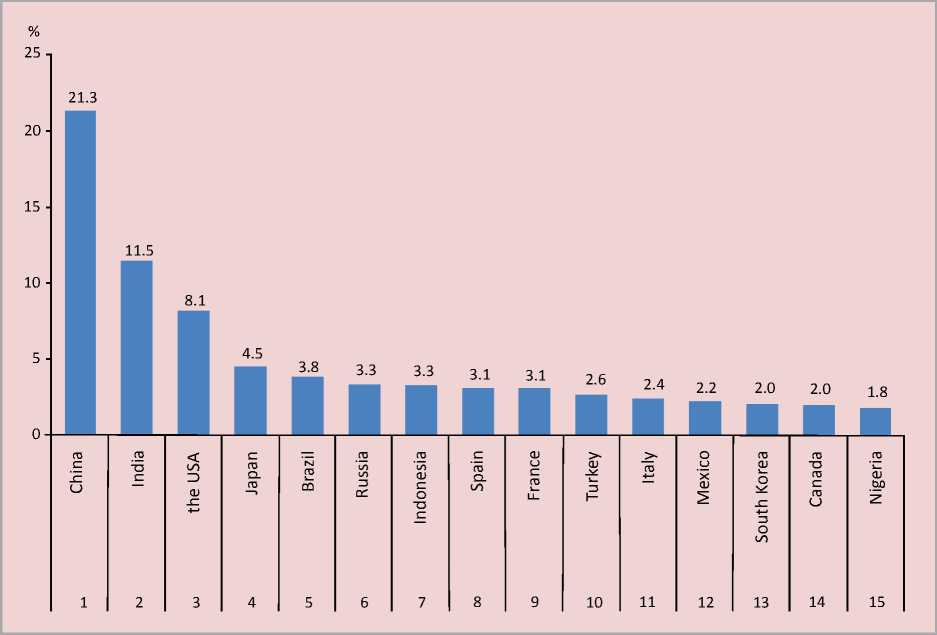
The present ideological design of this scheme includes intellectualized theories such as post-industrialism, or globalism.
Periphery provides the Western countries with the goods of real economic sectors. Moreover, each country included in the globalization peripheral system has its own niche in the world specialization. There are three types of such specialization:
-
1. “Banana republics”.
-
2. “Raw-material republics”.
-
3. “Assembly shop”.
Due to the support of peripheral countries, the West has been able to retrain for the primary development of service sphere, which is dominated by finance.
Russia, which has been reforming the national economy over last two decades, is going to be a semi-peripheral country of the second type in the global division of labour.
The process of economical deindustrialization in Russia became collapsed in the 1990s. They were, apparently, the highest service transformation rates in the history of the global economy. Deindustrialization of the 1990s revealed itself even in some increase in the share of agricultural and forestry employment. According to formal immanent signs, post-industrialism has come to Russia and has taken a form of economic and social archaism (fig. 12) .
The Russians have been more engaged in trade and financial transactions, but at the same time, they produce fewer commodities in the industrial and agrarian sectors9. In general, the trends of the Russian development under the chosen model are practically unquestionable in
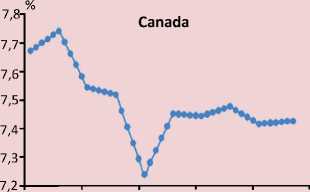
1960 1970 1980 1990 2000 2010
Figure 10. The share of cultivated agricultural land in the total acres of the world, % (according to the data of the Institute of World Economy and International Relations of RAS)

1960 1970 1980 1990 2000 2010

13,6
13,5
13,5
13,4
13,4
13,3
13,3
13,2
13,2
13,1
1960 1970 1980 1990 2000 2010
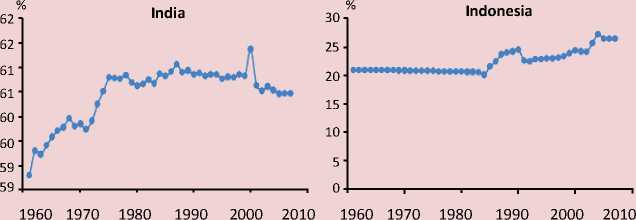

Figure 11. Modern neo-colonial model of the global division of labour
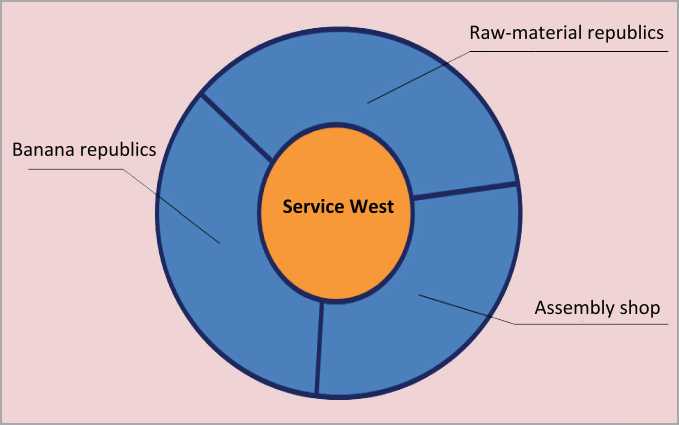
Figure 12. Average annual employment in the Russian economy (Source: Federal State Statistic Service)
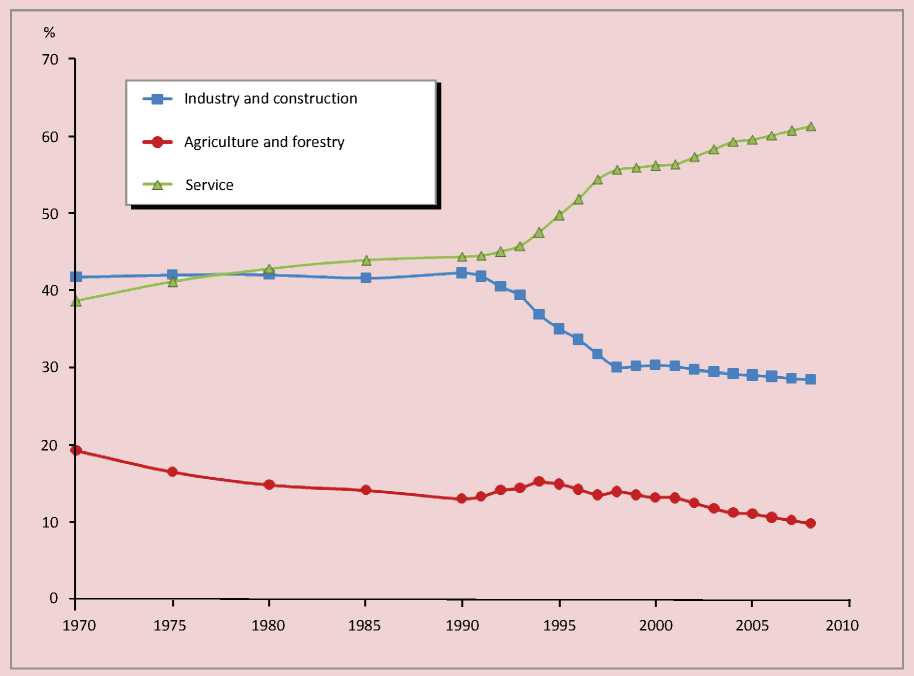
the coordinates of “improvement – deterioration” over 10 years (2000 – 2010).There is a general deterioration of many economic, social and humanitarian indicators of the country. Except for the pre-crisis growth in frozen sovereign funds and foreign trade turnover, other indicators become worse at the unacceptable level that is often record-breaking.
Thus, if we put it specifically, there is neither frontal stage post-industrialism nor appropriate post-industrial society nor post-industrial transition in the strict sense of the terms.
We can talk about the only spatial and temporal dynamics of the sectoral production structure. Globally, the mechanism, described here, reproduces the spatial structure of neocolonialism, including its modern form of financial exploitation. Informational frame of this model is the theories of “the End of History”, “The Clash of Civilizations”, “Global Islamic Terrorism” and, finally, the theory of post-industrialism. These concepts will inevitably occur in future.
Список литературы Post-industrialism: the experience of critical analysis
- Huntington S. The Clash of Civilizations. Moscow, 2006
- Yakunin V.I., Baghdasaryan V.E., Sulakshin S.S. New technologies to struggle against the Russian statehood. Moscow: Scientific Expert, 2009
- Inozemtsev V.L. Sociology of Daniel Bell and the contours of the modern post-industrial civilization. Problems of Philosophy. 2002. No. 5.
- Inozemtsev V.L. Post-industrial economy and post-industrial society: To the problem of social trends of the XXI century. Social Sciences and the present time. 2001. No. 3.
- Inozemtsev V.L. Beyond the economic society. Moscow, 1998.
- Tsaplin V.S. Post-industrialism: Are the claims justified? Sociological studies. 2006. No. 4.
- Bell D. The coming of post-industrial society: A venture of social forecasting. Moscow, 1999
- A new post-industrial wave in the West. Anthology, ed. V. Inozemtsev. Moscow, 1999
- Toffler E. The Third Wave. Moscow, 2004
- Krasilshchikov V.A. Guidelines for future: post-industrial society and the paradoxes of history. Social Sciences and the present time. 1993. No. 2
- Inozemtsev V.L. Modern post-industrial society: nature, contradictions, prospects. Moscow, 2000
- Khoros V.G. Post-industrial world -hopes and reality. Moscow, 2001
- Webster F. Theories of the Information Society. Tr. from English by M.V. Arapova, N.V. Malykhina. Ed. E.L. Vartalova. Moscow, 2004.
- Lunev S.I. Socio-economic development of the largest countries of Eurasia. Civilizational context. East -West -Russia. Moscow, 2002
- Maddison A. Monitoning the World Economy, 1820 -1992. Paris, 1995
- Radelet S., Sachs J. Asia’s Reemergence. Foreign Affairs, 1997, vol. 76, No. 6.
- La Rouche L. Physical economics. Moscow, 1997
- Tukmakov D. Assimilation to God (Physical economics by La Rouche as overcoming entropy)//www.zavtra.ru

